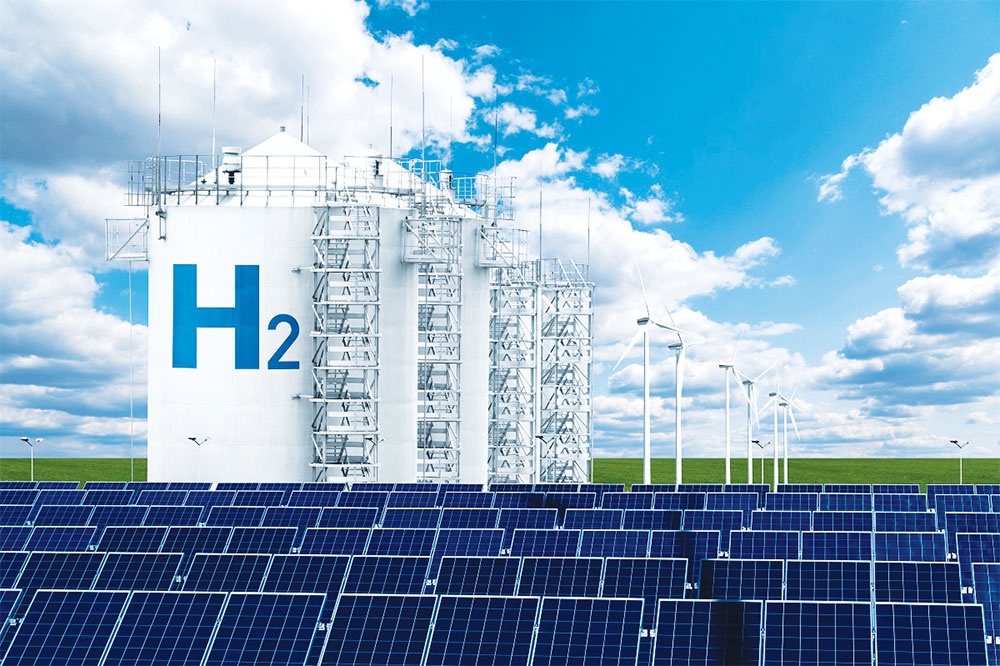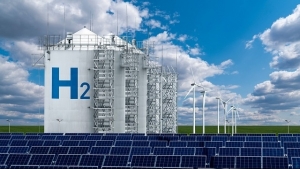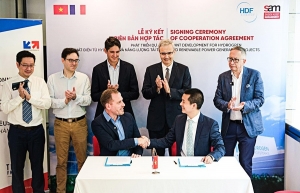Race for hydrogen energy heating up against backdrop of carbon-free future
Green hydrogen is produced when electricity is used to separate water into hydrogen and oxygen. According to Enterprize Energy Corporation, the produced hydrogen may be stored as liquid gas, making it appropriate for application in several areas and readily transportable.
 |
| Asia-Pacific is becoming more aware of the necessity to manufacture and utilise green hydrogen |
It is anticipated that the market size of the hydrogen economy will continue to expand significantly over time. According to a report published by the Nikkei BP Clean Tech Institute in 2013, even though the global market size of the hydrogen economy was only set to hit $80 billion in 2015, it is expected to grow at a fast pace to $400 billion by 2030, $800 billion by 2040, and $1.6 trillion by 2050.
Two months ago, Binh Thuan People’s Committee submitted a paper to the prime minister, the Ministry of Industry and Trade (MoIT), and the Ministry of Natural Resources and Environment, seeking to include Enterprize Energy’s Thang Long Wind gas power project 2 in the Power Development Plan VIII (PDP8). The Thang Long Wind 2 project proposes to manufacture hydrogen gas in the sea region off Ke Ga on the coast of Binh Thuan, with a capacity of 2,000MW, a total expenditure of $5 billion, and a projected implementation period from 2022 to 2030.
Potential to be utilised
Enterprize Energy delivers capital investments in Vietnam as the industry for hydrogen is gradually forming with industry sectors that are anticipated to have requirements for using hydrogen to substitute fossil fuels, such as transport, steel production, fertiliser production, and basic chemical production. Additionally, the expansion of hydrogen-powered stationary fuel cells and the development of fuel cell vehicles are indications that this trend is becoming a reality.
According to the draft PDP8 and the draft master plan for the expansion of the seaport system in the 2021–2030 period, Vietnam will concentrate on building the seaport system and infrastructure for the storage and transportation of liquefied natural gas (LNG) between 2025 and 2035. Along with the power grid development programme, these infrastructure projects are essential for Vietnam to be prepared to generate green hydrogen.
Since hydrogen generated from renewable energy has a greater production cost ($4-6 per kg) than hydrogen produced from fossil fuels, it cannot compete at the moment. Long-term prospects exist for developing green hydrogen generated by electrolysis innovation in Vietnam, given the country’s capacity and intent to develop renewable energy sources.
In addition, the Asia-Pacific region is becoming more aware of the necessity to manufacture and utilise green hydrogen, which increases the potential for renewable energy. Vietnam’s offshore wind energy and the direction of building seaport facilities, storing, and transporting LNG offers much potential to create a plan for a carbon-free future using green hydrogen.
Hurdles along the way
Due to the limited scientific and technological potential in the energy sector, the development of green hydrogen in Vietnam faces more hurdles than possibilities, according to a study by Le Viet Cuong and Nguyen Van Thao of the MoIT’s Institute of Energy in autumn 2021.
Hydrogen has not been emphasised as an inevitable part of Vietnam’s strategic energy planning, even though it is an optimum form of energy storage when combined with other renewable power sources and is expected to replace the burning of fossil fuels.
Vietnam is in the early phases of establishing hydrogen technology, encompassing several scientific and technological disciplines. The administration has not yet formulated or released a hydrogen roadmap, policy, development orientation, or research programme. This shortcoming will impact the development processes’ uniformity and stability. Consequently, the identification of objectives, tasks, and options for the development and execution of hydrogen is crucial, the study stated.
However, no departments, organisations, or agencies have formulated or issued legislative laws governing the administration of hydrogen development operations according to scope and subject. Investment initiatives for hydrogen generation are administered in accordance with organisations active in basic chemical manufacturing.
Mechanisms and regulations to encourage hydrogen growth, including direct power purchase agreements, providing auxiliary services for the power system, implementing carbon taxes and carbon market-carbon, and pooling infrastructure for transferring and storing hydrogen, would not yet be functional.
In addition, the legislative provisions lack the attribution of duties and responsibilities to the organisation and unit responsible for executing the unified state administration of this sector. The absence of a legislative framework is seen as an important issue by the study that must be addressed by departments and agencies.
Meanwhile, the planning for the expansion of the storage and transportation infrastructure of the LNG system and the transmission grid has not accounted for the requirements and public use mechanisms for the development of hydrogen.
The aforementioned constraints have connected effects that directly affect the outcomes of the hydrogen development process in Vietnam, the study said.
Considering the long-term growth direction of the energy system, the application of green hydrogen production technology for Vietnam’s hydrogen development is much-needed. Developing green hydrogen production in Vietnam, and the financing problem for specific projects are still implementable, provided an appropriate strategy is adopted.
Consequently, to effectively develop such projects, investors must use a holistic and comprehensive strategy including several scientific and technological disciplines, such as energy economics, electrical systems, chemistry and physics, the environment, transport economics, and public policy.
For Vietnam to become a producer and exporter of green hydrogen, enhance the efficiency of renewable energy, and fulfil the demands of foreign-invested firms, the country must quickly catch up with the global development of hydrogen. Specific short-and long-term solutions and tasks must be designed and implemented with simultaneous deployment and a sandbox mechanism rather than sequential deployment.
| Vietnam is dedicated to the long-term goals of generating renewable energy and conserving the environment. Government resolutions have established the following objectives: the proportion of renewable energy sources in the total primary energy supply will reach 15 to 20 per cent by 2030, and 25 to 30 per cent by 2045; greenhouse gas (GHG) emissions from energy activities are planned to be reduced from 20 per cent in 2030 to 15 per cent in 2045. The government also announced a revised version of Vietnam’s decided commitments under COP21 in 2020. Vietnam promised to cut its overall GHG emissions by 9 per cent compared to the base scenario by 2030 using local resources and increasing its international contribution to 27 per cent via multilateral collaboration, as well as implementing new Paris Agreement procedures. Decision No.38/2020/QD-TTg from 2020 declared that hydrogen energy is on the list of high technologies with investment and development priorities. The development of hydrogen energy technologies is vital. It encompasses green hydrogen generation technology, hydrogen transport and storage technology, and hydrogen use technologies in the future. Consequently, projects using hydrogen energy technology will be eligible for financial incentives in line with legislation governing high-tech investment. |
 | TGS Green Hydrogen to develop new plant for nearly $850 million TGS Green Hydrogen from Germany plans to develop a green hydrogen plant in the Mekong Delta province of Ben Tre with the total investment capital of VND19.5 trillion ($847.8 million). |
 | HDF Energy and Saigon Asset Management develop hydrogen power A signing ceremony for the corporation agreement between Hydrogène de France SA (HDF Energy) and Saigon Asset Management Corporation (SAM) for the development of a chain of hydrogen and renewable energy generation projects in Vietnam was held on July 25 at the French Embassy. |
 | Escalating national hydrogen production and exports When contemplating the growth of the hydrogen industry in Vietnam, it is necessary to examine the industry’s export focus towards key Asian markets. |
What the stars mean:
★ Poor ★ ★ Promising ★★★ Good ★★★★ Very good ★★★★★ Exceptional
Related Contents
Latest News
More News
- Heavy industries set for pilot greenhouse gas quotas (December 25, 2025 | 10:00)
- Swedfund invests in MSME growth and climate action in Vietnam (December 19, 2025 | 11:42)
- GreenYellow brings solar energy to light up remote schools in Tuyen Quang province (December 19, 2025 | 08:00)
- Charge+, Grab partner to develop EV charging network in Vietnam (December 18, 2025 | 17:11)
- Linking sci-tech and innovation to Vietnam’s net-zero future (December 18, 2025 | 14:31)
- Driving double-digit growth through green and circular transformation in Vietnam (December 17, 2025 | 09:00)
- Standard Chartered and ACCA deepen collaboration to develop Vietnam’s talent for a sustainable future (December 15, 2025 | 18:18)
- Schaeffler reports strong early output from Dong Nai solar project (December 12, 2025 | 15:16)
- Forestry conference highlights biodiversity and sustainability goals (December 09, 2025 | 13:35)
- Home Credit honoured among top 10 sustainable companies in trade and services (December 09, 2025 | 12:18)

 Tag:
Tag:





















 Mobile Version
Mobile Version